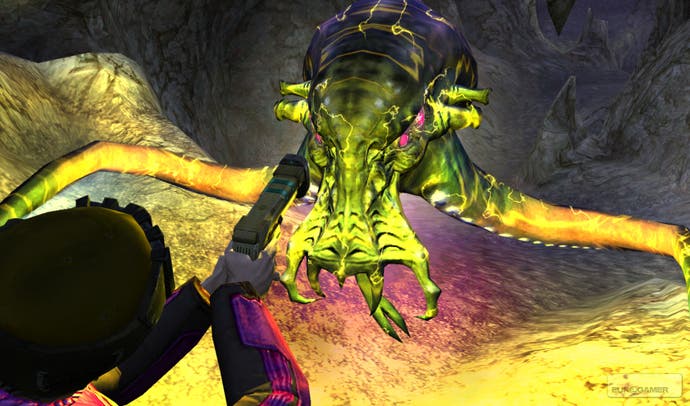Tabula Rasa: Getting Started
Tough love for new recruits.
So here we are in the Bootcamp. What you need to do is fairly self-explanatory - after talking to the commander, you'll get a few simple tasks and will then be chucked into a battle against a few Thrax enemies. Nothing too strenuous, and as you go along you'll have your hand held for most of the way.
You can, of course, skip out of the Bootcamp level entirely. Near the starting point there's a character called Captain Burba, who can ship you straight to the first zone in the game - but if you're a new player, this really isn't recommended, and bear in mind that there's no way of coming back here to do the training again.
Over the course of the Bootcamp, you'll get to do a base assault mission, venture into a nearby cave to claim a Logos power, and fight a couple of boss enemies - and on your return, you'll have to do a base defence mission, where you take out attacking forces and don't let them breach the base or touch the capture point. All of this is useful, because it's exactly the sort of thing you'll be doing in the main game, for the first couple of dozen hours, at the very least. Getting a chance to learn the ropes solo before you enter the big bad multiplayer world is very handy.
Combat Fatigues

There are a few more things that you'll notice as you make your way through the Bootcamp missions, and which merit explanation in a bit more depth than the game itself manages. For a start, most enemies have two status bars, because they have a Shield bar as well as a Health bar - and until the Shield bar has been shot to bits, your bullets won't be hurting the soft, fleshy bits underneath at all.
This is one of the pivotal systems in the game, and it's a good introduction to the mainstay of the game's combat - the idea of combined arms. Shields, you see, aren't vulnerable to the same things that soft flesh is vulnerable to. Certainly, you can make a mess of both of them with bullets, and that's exactly what you'll be doing for much of the early part of the game - but as you progress, you'll have the option to be much, much cleverer than that.
Shields, for instance, are vulnerable to EMP - electro-magnetic pulses, which are created by many of the weapons, bombs and abilities you'll acquire. As such, a more efficient way to take down shielded enemies is to hack their shields off with EMP based attacks, then to switch to more conventional attacks in order to slash their health. Early in the game, your Lightning ability is the best EMP based attack at your disposal, but it's far from the only one available.
Other types of enemies have different vulnerabilities, so TR's "weapon tray" - the quick-select box in the bottom left which allows you to cycle through equipped weapons with the Q key - starts to make a lot more sense. You'll be using it (and its companion, the quick-select box for abilities) a lot.

The combined arms concept goes beyond simple elemental differences, though. One of the things we like most about Tabula Rasa is that different classes of weapons in the game behave in really distinct ways - and swapping between EMP and physical damage weapons is only the tip of the iceberg.
For instance, you'll probably have noticed by the end of Bootcamp that you've been given a number of different weapons - a Shotgun, a Pistol and a Rifle, to be precise. Far from being simply a matter of picking the one with the best stats and sticking with it, each of those weapons is actually useful in different circumstances - and you'll want to switch between them as the tactical situation demands.
The pistol, your first weapon class, is something of an all-rounder. Not terribly powerful, it's got both decent range and a good punch close-up, and it doesn't take long to lock on to an enemy. The rifle and the shotgun, however, are polar opposites. Shotguns are incredibly powerful close-up, so much so that they're actually capable of sending enemies flying backwards on occasion - while the rifle is a long-range weapon, which is at its best when an enemy is far away, and you're crouched down and able to spend some time focusing your aim.
Later in the game, plenty of other weapon types will be added - the first being Chainguns (if you choose to develop your character down the martial Soldier route) and Leech Guns (for characters who go down the more support-focused Specialist career path). The former are a rapid-fire type of weapon, and great in a big scrap; the latter is a continuous beam that doesn't do that much damage, but heals you and your teammates as it goes.


